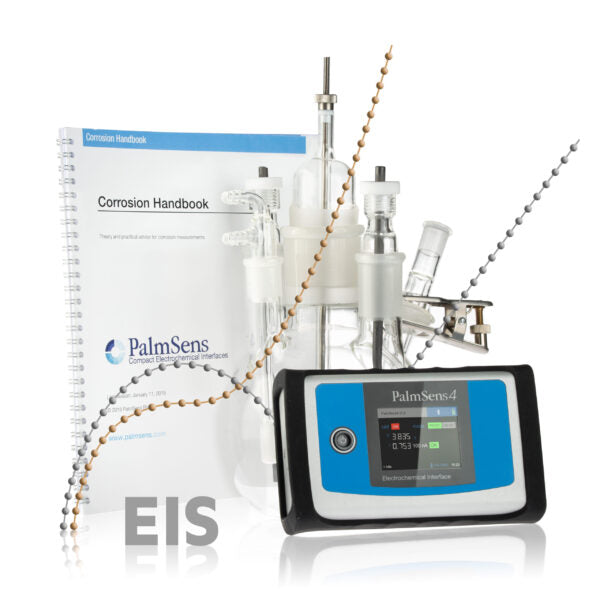EIS Plus Corrosion Package
Couldn't load pickup availability
Delivery and Shipping to EU
Delivery and Shipping to EU
We will add in the quotation, the shipping, insurance, customs clearance costs.
EIS Plus Corrosion Package
PalmSens
Create polarization curves, Tafel plots, EIS and more
- Supports all common corrosion techniques
- Includes cell, cables, and handbook
- Includes PalmSens4 potentiostat with EIS up to 1 MHz
Description
This EIS Plus Corrosion Package includes everything you need to get started with corrosion measurements.
The included instrument is the PalmSens4 which is a USB and battery-powered Potentiostat, Galvanostat, and Electrochemical Impedance Spectroscopy (EIS) analyzer. The PalmSens4 has a large potential range (-10V to 10V) and current range (100 pA to 10 mA) with a high resolution and low noise. This instrument is a complete laboratory instrument but its compact and rugged design makes it also ideal for fieldwork.
PalmSens4 allows for a wide range of corrosion analysis methods; polarization curves to extract the Tafel slopes, corrosion rates, corrosion current, apply a current to the surface for electroplating, deposit films, or force corrosion to happen. Additionally, you can perform EIS (Electrochemical Impedance Spectroscopy) from 0.1 µHz to 1 MHz, which will allow you to extract the coating resistance, the polarization resistance, the pore resistance, the coating capacitance, water uptake of a coating and to estimate the time to failure (TTF). The instrument comes with PSTrace5 software which allows for different corrosion analytical techniques for automatic or manual analysis.
Together with our Corrosion Handbook and the Corrosion Cell Kit, it makes a good combination to get going with electrochemical corrosion studies.
Electrochemical Impedance Spectroscopy (EIS)
EIS allows observing: changes on surface properties, pitting corrosion, water uptake of a coating, estimation of delamination area and estimation of time to failure
Standard included with an EIS Plus Corrosion Package
- Corrosion Cell
- Corrosion Handbook
- PalmSens4
- Rugged carrying case
- High quality, double shielded cell cable with 2 mm banana connectors for Working, Counter, Reference electrode, Sense and Ground
- Crocodile clips
- USB cable
- Manual and Quick Start document
- PSTrace software for Windows
Techniques
Corrosion techniques
- Potentiostatic Polarization
- Galvanostatic Polarization
- Linear Polarization
- Cyclic Polarization
- Corrosion Potential
- Electrochemical Impedance Spectroscopy (EIS)
Voltammetric techniques
- Linear Polarization
- Cyclic Polarization
- Differential Pulse Voltammetry (DPV)
- Square Wave Voltammetry (SWV)
- Normal Pulse Voltammetry (NPV)
- AC Voltammetry (ACV)
- Stripping chronopotentiometry (PSA or SCP)
Stripping modes
The voltametric and pulsed techniques can all be used in their stripping modes which are applied for (ultra-) trace analysis.
Technique as a function of time
- Corrosion Potential Measurement
- Chronoamperometry (CA)
- Pulsed Amperometric Detection (PAD)
- Multiple Pulse Amperometry (MPAD)
- Fast amperometry (FAM)
- Chronopotentiometry (CP)
- Multistep Amperometry (MA)
- Multistep Potentiometry (MP)
- Mixed Mode (MM)
Impedance spectroscopy / EIS
- Potential scan
- Time scan
- Fixed potential
Two types of scans
Scans can be made at a fixed frequency or with a frequency scan.
SPECIFICATIONS
|
General |
|
|
dc-potential range |
±10 V (or ±5 V) * |
|
compliance voltage |
±10 V |
|
maximum current |
±30 mA (typical) |
|
max. acquisition rate |
150,000 data points/s |
|
* depending on PalmSens4 hardware configuration |
|
|
Potentiostat (controlled potential mode) |
|
|
applied dc-potential resolution |
76.3 µV ( 18-bit ) |
|
applied potential accuracy |
≤ 0.1% ±1 mV offset |
|
current ranges |
100 pA to 10 mA (9 ranges) |
|
current accuracy |
≤ 0.1 % (at Full Scale Range) |
|
measured current resolution |
0.005 % of current range ( 18-bit , 5 fA on 100 pA range) |
|
Galvanostat (controlled current mode) |
|
|
current ranges |
1 nA to 10 mA (8 ranges) |
|
applied dc-current range |
±6 times applied current range |
|
applied dc-current resolution |
0.0076% of applied current range (<10 mA) |
|
measured dc-potential resolution |
78.13 μV at ±10 V (gain 1, 18-bit ) |
|
measured dc-potential accuracy |
≤ 0.05% or ±1 mV (for |E| < ±9 V) |
|
FRA / EIS (impedance measurements) |
|
|
frequency range |
10 μHz to 1 MHz (or 10 μHz to 100 kHz) * |
|
ac-amplitude range |
1 mV to 0.25 V rms, or 0.7 V p-p |
|
* depending on PalmSens4 hardware configuration |
|
|
GEIS (galvanostatic impedance measurements) |
|
|
frequency range |
10 μHz to 100 kHz (or 10 μHz to 100 kHz) |
|
ac-amplitude range |
0.001 x CR to 0.4 x CR (<10 mA) CR to 0.2 x CR (10 mA) CR = current range) |
|
Electrometer |
|
|
electrometer amplifier input |
> 1 TΩ // 10 pF |
|
bandwidth |
1 MHz |
|
Other |
|
|
housing |
aluminium with rubber sleeve: 15.7 x 9.7 x 3.5 cm3 |
|
weight |
+/- 500 g |
|
temperature range |
0 ºC to + 50 ºC |
|
power supply |
USB or internal LiPo battery |
|
communication |
USB and Wirelessly (Dual Mode) |
|
battery time |
> 16 hours idle time |
|
internal storage space |
8 GB |
|
Auxiliary port (D-Sub 15) |
|
|
analog input |
±10 V, 18-bit |
|
analog output |
0-10 V, 12 bit (1 kOhm output impedance) |
|
4 digital outputs |
0-5 V |
|
1 digital input |
0-5 V |
|
i-out and E-out |
raw output of current and potential |
|
power |
5 V output (max. 150 mA) |



